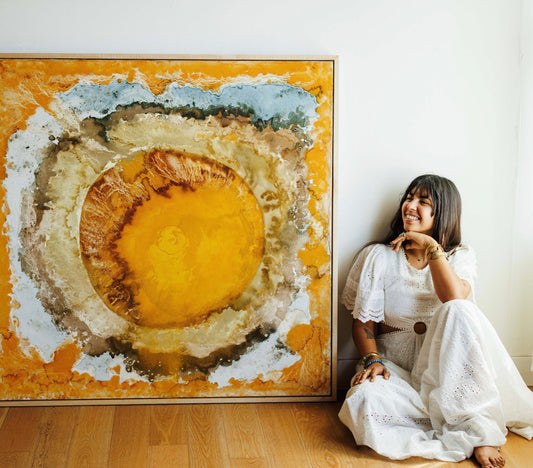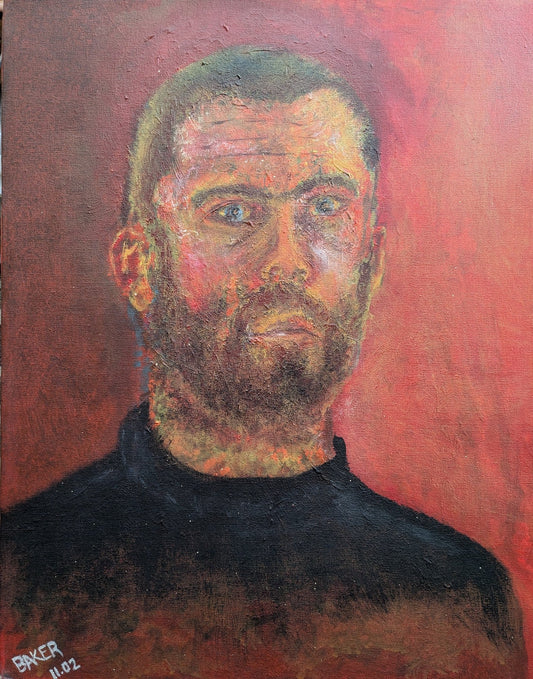Background
The work of Francesco Ruspoli transcends facial expressions and words. While the colorful figures are expressionless, viewers are able to observe their intimacy and sensuality through their embodiment and body language. Using only color, form, and figuration, Ruspoli effectively communicates intimacy, pain, love, and togetherness. In an age where a lack of connectedness is so prominent, Ruspoli seeks to portray his canvas as one ideal world where perhaps all human beings are connected, selfless, and compassionate. His art expresses the fundamental aspects that make up all of humanity. Speaking with Ruspoli, his passion for human relationships and what they can contribute to the world at large is electrifying. Acutely philosophical, insightful, and imaginative, Francesco Ruspoli is an artist who should not be overlooked.
Born in Paris to a British mother with a French background and a Belgian father with an Italian background, Ruspoli’s multicultural upbringing has powerfully impacted his art and its themes. His multinational exposure today began with his earlier fascination with past traditions and innovations in art, which he translates into his own expression. Ruspoli explains,
“The rich artistic melting pot of Paris and the modernist movement inspired much of my work, along with great British artists such as Auerbach and Sutherland. Early in my artistic development, I had a fascination with the surrealists such as Magritte and Dali, who inspired me to weave the world of the unconscious and unseen into my work. Interestingly, I have often been inspired by great Renaissance masters such as Veronese, especially in the epic grandeur of his crowd scenes.”

Childhood Motifs
Ruspoli’s childhood was staged in the vibrant and culturally abundant landscape of Antibes, France. One of his primary influences, Matisse, experienced a similar journey to Ruspoli’s —from the north to the south of France. Ruspoli also studied at Nice University, in the city where Matisse finally made his home. Ruspoli explains his connection to Matisse and Nice by saying, “The same light shone on me that had such a profound impact on him when he [Matisse] arrived, [Ruspoli quoting Matisse]: ‘When I realized that every morning I would see this light again, I could not describe my joy. I decided not to leave Nice, and I stayed there practically all my life.’” Additionally, Ruspoli shares Matisse’s philosophy about his art. Ruspoli says, “Many of his thoughts about his art resonate deeply for me: ‘All my colours sing together, like a chord in music.’”
The motif of connectedness finds its root in Ruspoli’s childhood as well. He says, “My parents were often absent, leaving me in the care of my strict grandmother. This certainly nourishes my focus on relationships in their tensions and flow: attachment, rupture, repair, and group dynamics. Many people feel a yearning for connection in my work.”
In addition to the picturesque landscape of his childhood, Francesco Ruspoli is also profoundly inspired by the traditions of Roman Catholicism, especially the stained glass art in cathedrals. “It is often said my paintings are reminiscent of stained glass windows: a sensually luminous use of colour and outline that represents a window into a deeper, unseen world of spirituality, the unconscious and the human psyche," Ruspoli says. In the same way that stained glass church windows inspire reflection, meditation, and spirituality, Ruspoli’s paintings are highly emotive.

Creative Process
Ruspoli’s primary medium is oil paint. He says, ‘Paint on canvas for me is the most noble art form one artist could ever do. It involves skills and talent directly from the soul.” His creative process is one of great discipline and mindfulness. Ruspoli says that he begins his creative process, acting as an archeologist of his own imagination as he looks to origins of the piece in art, dance, or theatre of previous eras. He constantly works through his idea’s development on the canvas. This, Ruspoli says, requires a Zen-like mental headspace, so he can completely clear his mind and focus on creating the art so it can eventually create itself. Though this process is laborious, it is the only way Ruspoli has found to replicate authenticity in his work.
Color is a vital aspect of Ruspoli’s work. The sensuous physical presence of each figure is articulated in Ruspoli’s vibrant polychromatic technique. Red, Ruspoli explains, is the color of blood, representing our universal life force. Blue is happiness, the goal of humanity and human relationships. Green is representative of nature, which provides us all with an innate desire to love our environment. This simplistic universal visual language communicates with viewers beyond cultural and linguistic barriers.

Ruspoli’s primary medium is oil paint. He says, ‘Paint on canvas for me is the most noble art form one artist could ever do. It involves skills and talent directly from the soul.” His creative process is one of great discipline and mindfulness. Ruspoli says that he begins his creative process, acting as an archeologist of his own imagination as he looks to origins of the piece in art, dance, or theatre of previous eras. He constantly works through his idea’s development on the canvas. This, Ruspoli says, requires a Zen-like mental headspace, so he can completely clear his mind and focus on creating the art so it can eventually create itself. Though this process is laborious, it is the only way Ruspoli has found to replicate authenticity in his work.
Color is a vital aspect of Ruspoli’s work. The sensuous physical presence of each figure is articulated in Ruspoli’s vibrant polychromatic technique. Red, Ruspoli explains, is the color of blood, representing our universal life force. Blue is happiness, the goal of humanity and human relationships. Green is representative of nature, which provides us all with an innate desire to love our environment. This simplistic universal visual language communicates with viewers beyond cultural and linguistic barriers.
Support Francesco Ruspoli’s art by visiting his website www.francescoruspoliart.com
Instagram: @francesco.ruspoli
Representative gallery: www.gabrielfinearts.com
©ArtRKL™️ LLC 2021-2023. All rights reserved. This material may not be published, broadcast, rewritten or redistributed. ArtRKL™️ and its underscore design indicate trademarks of ArtRKL™️ LLC and its subsidiaries.





